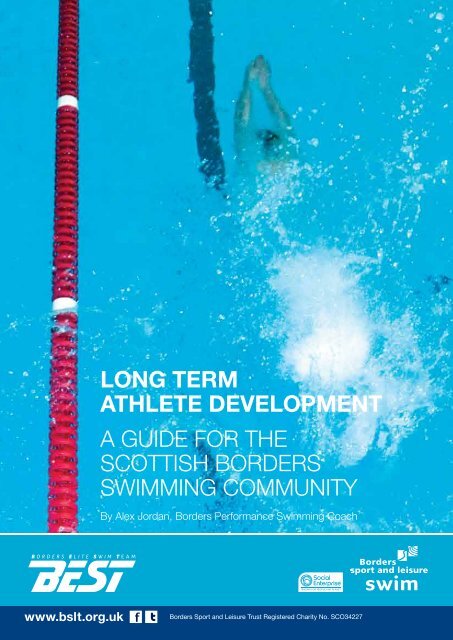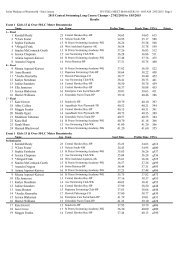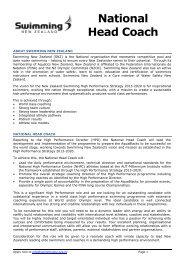LTAD Borders Swimming Community - Final
LTAD Borders Swimming Community - Final
LTAD Borders Swimming Community - Final
Create successful ePaper yourself
Turn your PDF publications into a flip-book with our unique Google optimized e-Paper software.
TRAINING FREQUENCIES & VOLUMESThe table below displays training frequencies and durations for the four group levels that a number of <strong>Borders</strong> clubsimplemented with the advent of the <strong>Borders</strong> Performance Development Programme in June 2008. These levels andrecommendations are aligned to the British <strong>Swimming</strong> Long Term Athlete Development model.It is quite obvious to coaches when a swimmer must be moved down a level due to their stage of development &/or standard of performance. However, the decision to move a swimmer up a level should not be taken lightly and theserious consideration of a number of factors is required.Clubs with swimmers training more frequently andcompleting higher volumes, within recommendedranges, will almost always produce morecompetitive swimmers over the long term. Thisseems obvious but there are still many swimmerswith competitive aspirations who do not completeenough training. There simply is no substitute forhard work and commitment.LEVEL ONEMeeting recommended training frequencies, and thedevelopment of technique and skills in a fun environment,takes precedence over workload in this group level.The <strong>LTAD</strong> model recommends that children in Level Oneparticipate in general sport activities five to six timesper week. This should include land work and multisportactivity. Put simply, participation in a wide range ofsporting activities is recommended in order for children todevelop a wide range of skills and abilities for the future.From the suggested five to six “general sport” sessionsit is recommended that <strong>Borders</strong> swimmers completethree of those sessions in the pool. One of the reasonsfor recommending a higher proportion of swimming overother sports is that a greater proportion of time isrequired (in the water) to comprehensively develop swimspecific skills compared to that required for developingland-based skills.LEVEL TWOCoaches should prescribe the correct volumes and activitiesfor their swimmers according to their chronological &/orbiological age – if the swimmer is also capable of becomingmore competitive on this amount work this is a bonus.Parents and swimmers must focus on the process ratherthan the result. However, few children will continue withtheir sport if they are not experiencing some competitivesuccess at all stages. Pre-pubertal swimmers race withspeed through well-developed aerobic/endurance systems.Therefore adequate training volumes are essential for thisgroup level.Level 2 swimmers should be aiming at 8,000m -16,000m/week. Therefore if a Level 2 swimmer isattending the recommended 4 sessions per week theyshould be completing a minimum of 2,000m per session.Swimmers will need sessions of up to 1.5 hours tocomplete these volumes. This should be occurring over44 to 48 weeks of the year.
LEVELS THREE A, B & FOURAt the beginning of Level 3A swimmers should becompleting 24,000m - 32,000m/week. Therefore if aLevel 3A swimmer is attending the recommended 6sessions per week they should be completing a minimumof 4000m per session. Swimmers will need sessions ofup to 2 hours to complete these volumes. This should beoccurring over approximately 48 weeks of the year.By the end of Level 3B the swimmers should be aimingat 44,000km – 52,000m/week. Therefore if a Level 3Bswimmer is attending the recommended 8 sessionsper week they should be completing a minimum of5,500m per session. Swimmers will need sessions of upto 2 hours to complete these volumes. This should beoccurring over 48 weeks of the year.Level 4 swimmers should be doing similar or slightly highervolumes to Level 3B swimmers each session, but should beaiming to train over ten sessions per week. Swimmers willneed sessions of up to 2 hours to complete these volumes.This should be occurring over 48 weeks of the year.WHY DO SWIMMERS NEED TO TRAIN SO MUCH?It’s common knowledge that participants of manyteam sports can often perform at the national level onjust two or three training sessions per week. This iscertainly not the case for swimmers – the norm for highschool-aged swimmers in Australia and the U.S.A. is10 two hour pool sessions per week plus additionalland training activities. So why do swimmers train somuch?Adaptation to the Medium of Water and <strong>Swimming</strong>Activity – The more often a human swims the morequickly and effectively their body and senses adapt towater, and the activity of swimming. An example of anadaptation to water is the increased “feel” swimmersoften develop for reducing drag and for manipulatingthe water for maximum propulsion. An example of anadaptation to swimming specific activity is an increasein general size and strength of the upper body while thelegs of swimmers remain generally quite underdevelopedin comparison. As land-based animals, water is notthe natural environment of humans. Therefore, tofacilitate greater adaptation to the water for increasedperformance, young humans should swim often whilegrowing and developing. This is why it is so important foryoung swimmers to be in the water frequently, rather thanless often but for longer periods. For example, four 1.5hour training sessions per week are more beneficial thantwo 3 hour sessions per week.Development of Feel, Depth Perception & SpatialAwareness – Swimmers who train more often tendto develop a greater “feel for the water”, an increasedperception of the depth of their body after starts andturns, and improved spatial awareness in the water...which, for example, is useful for a swimmer in knowinghow far from the wall they should prepare for a turn orfinish. These intuitive qualities, which collectively couldbe referred to as the “art of swimming”, are developedto a greater degree the more frequently swimmers train,particularly while still growing and developing.Establishing Automatic Movement Patterns ThroughRepetition – As for all sports, repetition ofmovement establishes habitual movementpatterns. Once the neuromuscularsystem has been exposedto sufficient repetition of aparticular movement pattern,desirable techniques andskills can be performedmore easily andautomatically.Creating a Foundation– Within both an entireswimming career anda single preparation/season, swimmers mustestablish an aerobic andtechnical foundation, throughcompleting significant trainingvolumes, on which to developall components of fitness morecomprehensively.Recovery – Active recovery from significant workloads isgenerally accepted as being more effective than passiverecovery (i.e. remaining idle). The need for active recoverysubsequently leads to a requirement for additionaltraining sessions.Windows of Opportunity – There are critical periods,during a human’s development, of optimal trainability forvarious components of fitness. These critical periods areoften referred to as windows of opportunity. It is generallyaccepted by sports scientists and coaches that if thedevelopment of a component of fitness is neglectedduring its window of opportunity, the athlete will neverdevelop that component to its optimum, no matter howmuch time and effort is spent on trying to develop it later.It is essential that enough time is spent training relevantcomponents of fitness during critical periods.
Pathway – By training adequately when young, <strong>Borders</strong>swimmers can be developed within the clubs along apathway focused on providing them with the skills andabilities to eventually move into the BEST PerformanceSquad and beyond. Learn to Swim4Club Training4ClubTraining + BEST Performance Squad + Athlete SupportProgramme4Club Training + BEST Performance Squad+ Scottish Institute of SportBecause they Can – <strong>Swimming</strong> is a weight-supported,low impact sport which allows the body to absorb ahigher frequency and volume of training comparedto other sports. Over time, this has led competitiveswimmers to progressively increase the amount oftraining they complete in order to gain an edge over theirrivals.RECOMMENDED ACTIVITIES &WINDOWS OF OPPORTUNITYThere are periods during an athlete’s growth anddevelopment where certain skills and abilities can betrained more easily and to a greater degree than duringother periods. Sports scientists and coaches agree thatif these windows of opportunity are neglected during aswimmer’s development, the swimmer will never developthe corresponding components of fitness totheir maximum potential... no matter howhard they work at it in the future. Forexample, if an athlete completesa large proportion of aerobic/distance training after thewindow of optimal trainabilityfor aerobic capacity, they willimprove their endurance, butnever to the extent that couldhave been possible.Swimmers performing lessthan the recommended volumeof training as outlined in the British <strong>Swimming</strong> <strong>LTAD</strong>Framework risk not only under-training, but are also likelyto neglect performing activities that develop the targetedelements of the various windows of opportunity duringtheir optimal stage of development.Conversely, swimmers performing over-advancedand inappropriate activities for their developmentalage, or completing greater volumes of training thanrecommended in the <strong>LTAD</strong> Framework, risk not onlyover-training, but also risk performing activities that donot correspond with critical periods.COMPETITION“Overemphasising competition in the early phases oftraining will always cause shortcomings in athletic abilitieslater in an athlete’s career” I Balyi and A Hamilton.Dr Istvan Balyi, quoted above, is considered by many tobe the world’s leading expert on <strong>LTAD</strong> and all/most ofthe content in the British <strong>Swimming</strong> <strong>LTAD</strong> Framework issupported by his work. Dr Balyi warns that the biggestnegative impact on performance is over competing.British <strong>Swimming</strong>’s former Performance Director, BillSweetenham, stated that he believed Britishswimmers raced too much and trained toolittle. We must ensure this does notoccur here in the <strong>Borders</strong>. Whilethe situation in Britain may haveimproved since Sweetenham’stenure, some are of the opinionthat it can still do with muchimprovement.“Competition is a goodservant but a poor master!”
FOCUSSING ON THE PROCESS RATHER THAN THE RESULT –THE KEY TO FUTURE SPORTING SUCCESS!It is not a coach’s job to get age group and youthswimmers racing as quickly as possible – it is a coach’sjob to get age group and youth swimmers racing asquickly as possible whilst adhering to <strong>LTAD</strong> principles.When a coach is following <strong>LTAD</strong> principles, and adeveloping swimmer is achieving their full potentialunder these circumstances, it must be understood thatthese short term results, however un/competitive, areadequate for the time being, while the swimmer also hasan increased likelihood of achieving their full potential asa senior athlete in the future.Parents (and swimmers) need to understand thatperformance cannot be accurately assessed by times andresults achieved. Performance should be assessed bydetermining how closely a swimmer follows their race planand how close they have gone to achieving their potential.A swimmer’s body is not always capable of producingPB’s, even when a race plan is followed perfectly.Remember that a PB is a result, not a process, and toohigh an emphasis can be placed on the achievementof PB’s. The only thing swimmers are in control of inproducing their best possible result is getting the processcorrect. Properly focussing on the process involves:consequently make more sensible decisions on the activitiesthey prescribe to their swimmers. Parents are more likely tobe content that their child is performing to their potential…which is all we can possibly expect of them. Mostimportantly, swimmers are more likely to perform at theiroptimum when they, and everybody around them, view theirperformances with appropriate perspective.Focussing on the process rather than the result will makethe sport more enjoyable for all parties, while also beingmore likely to produce positive competitive results overthe long term.The progression in figure 1 below identifies five stages oflong term athlete development. Note the emphasis onthe process/training comes earlier in the progression thanthe focus on competing, while the emphasis on results/winning comes even later still.• Parents and athletes should understand that aswimmer cannot be expected to achieve more thantheir full potential, but they should not be satisfiedwith achieving anything less than their full potentialon the amount of training they have committed to.1) Prior to competition – the swimmer’s trainingperformances and lifestyle practices over thelong term;2) On race day – The quality of the swimmer’s preand post-race practices (e.g. hydration, refuelling,warm ups and warm downs etc); and3) On race day – the swimmer’s race performancecompared against their race plan and theirperceived potential.A swimmer’s body will produce only the result it iscapable of on the day if these three points are adheredto, and no amount of impatience or focussing on resultscan alter this fact.When parents (and swimmers) accept all of the above, aconsiderable amount of pressure is removed. Coachesare more likely to feel less pressure to get results and• Coaches and parents should not expect childrento perform training activities designed to achieveshort term results. Rather, coaches should beplanning training based on long term athletedevelopment principles. If the child is physically,psychologically and emotionally ready to makeimmediate improvements under thesecircumstances it is a bonus in the short term.• There are so many factors affecting performancethat parents and swimmers should not compareperformances with those of other athletes.• Parents should focus on their child’s efforts ratherthan on PB’s, winning or losing.• Parents should leave it up to their child’s coach toprovide evaluation and feedback on performances.Figure 1“Losing is not coming second. It’s getting out of the water knowing you could have done better.For myself, I have won every race I’ve been in.”Ian Thorpe“If I am nothing without a gold medal, then I will be nothing with it.”Kirstie Marshall, aerial skier & multiple world cup medallist
PREMATURE STROKE/EVENT SPECIALISATIONAs a general rule swimmers should not specialise in aparticular event or stroke until they are 16 years or over(females)/18 years or older (males). Early specialisationcan lead to troublesome musculoskeletal imbalances.In any case, an athlete’s main event cannot properly beidentified until they have fully matured anyway. Swimmersbenefit in many ways from performing all strokes anddistances during training and competition throughouttheir development. Swimmers can also perform better orworse than expected in a given event from year to yeardue to on-going growth and development. It is importantthat a swimmer’s competitive future is not jeopardisedby focussing on a particular stroke/event when youngerwhile neglecting the development of other strokes/eventswhich may suit them more in the future. Neglecting thedevelopment of these events early in one’s career willleave swimmers’ ill-equipped to tackle them later in theircareer when they may be better suited to these events.Comparison between Early Specialisation versus General Development (Harre, 1982), DDR.RESPONSIBILITY & INDEPENDENCEIndependence and the ability to accept responsibility areessential life skills for everyone. Not only does possessingthese skills assist a swimmer to excel in and out of thepool, but sport is a great means for developing theseskills in general. Parents should support coaches inencouraging swimmers to take responsibility for theirperformances and in being honest with themselvesabout their efforts. Parents should support the coach inencouraging swimmers to develop independence andbecome ‘self-regulating’ wherever appropriate.
THE BORDERS PERFORMANCE DEVELOPMENTPROGRAMME/BORDERS SWIMMING PROGRAMMESThe <strong>Borders</strong> Performance Development Programmeinvolves a partnership between Scottish <strong>Swimming</strong>,<strong>Borders</strong> Sport and Leisure Trust and five local <strong>Borders</strong>clubs. The five member clubs are Duns, Gala, Kelso,Peebles and Teviotdale Amateur <strong>Swimming</strong> Clubs. Sinceits inception in June 2008, the <strong>Borders</strong> PerformanceDevelopment Programme has provided its memberclubs with an opportunity to improve the services theyprovide to their members by aiming to establish qualityclub training programmes following long term athletedevelopment recommendations.In late 2008, a number of <strong>Borders</strong> clubs went through astandardisation process to ensure their squad levels werein line with the various levels of the <strong>LTAD</strong> model.Member clubs are striving to provide the best possibletraining programmes to their members but manyclubs are limited due to a lack of resources. Clubsoften struggle to attract volunteer coaches and secureadditional pool time. The requirement of suitable lanetime often places an additional strain on club finances. Allswimming families are investing time and money in theirchildren’s swimming development. It therefore makessense for parents to ensure they help their clubs to thriveand run efficiently so their children can get the most outof the experience. Parents can help here by:• Assisting with club coaching;• Providing support to club coaches;• Training to become a swimming official;• Ensuring their children regularly take advantage ofpool time to ensure it is not taken away from theclub;• Assisting with club fundraising;• Becoming a member of the club committee;• Publicly supporting the committee and clubcoaches; and• Expecting to pay good money in return for a qualityclub training service.If clubs are receiving enough assistance from parents andvolunteers, and can work to gain access to adequateresources, the club then has an obligation to provide aquality service to their members.While many <strong>Borders</strong> clubs are striving to provide therecommended amount of pool time to their Level Oneand Level Two swimmers, it is difficult for clubs toprovide enough pool time for Level Three swimmers andbeyond. The BEST Performance Squad, an initiative ofthe <strong>Borders</strong> Performance Development Programme,was established in September 2008. This squad forambitious, committed <strong>Borders</strong> swimmers, was formedto increase the amount of training available to eligible<strong>Borders</strong> swimmers. Now, in conjunction with club trainingprogrammes, the BEST Performance Squad providesmany <strong>Borders</strong> swimmers with the opportunity to meetthe recommended workloads outlined in the British<strong>Swimming</strong> Long Term Athlete Development Framework.




